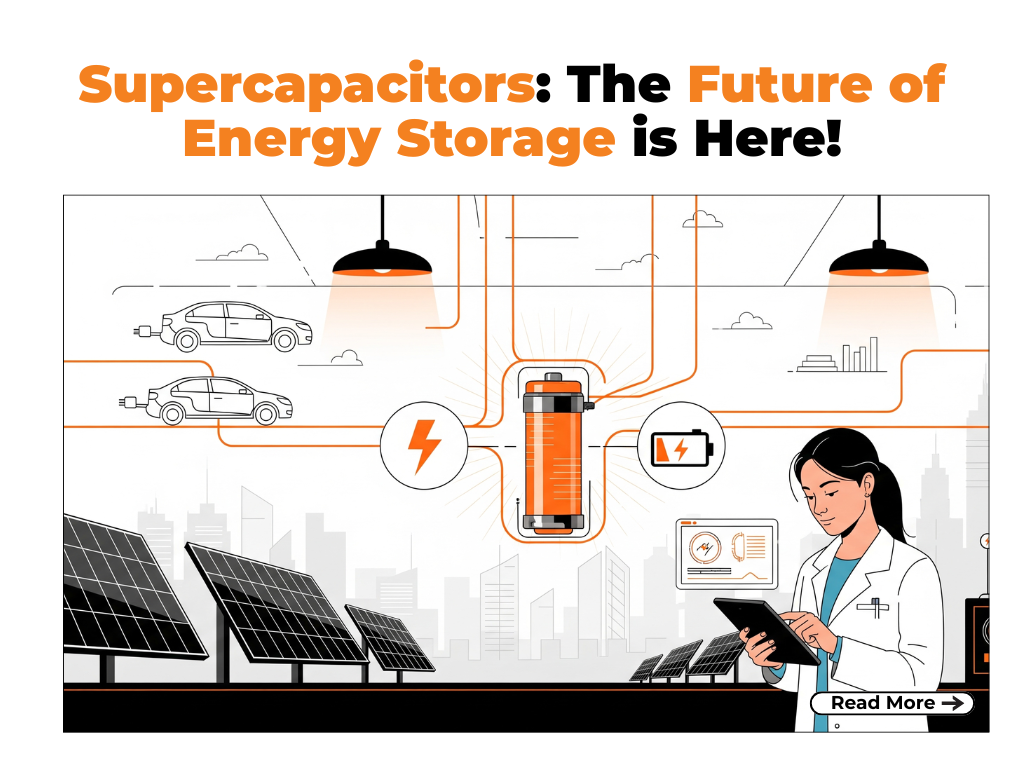 In today’s fast-paced technological landscape, the demand for energy storage solutions that are not only efficient and high-performing but also environmentally sustainable is greater than ever before. Whether it’s powering electric vehicles, stabilizing renewable energy grids, or supporting smart electronics, modern systems require storage technologies that can deliver rapid bursts of energy, withstand millions of cycles, and recharge in seconds. For decades, lithium-ion and other chemical-based batteries have served this purpose—but their limitations in terms of charging time, lifespan, and ecological impact are becoming more apparent. As innovation surges forward, a promising alternative is emerging to meet these modern energy demands: supercapacitors. With their exceptional power density, ultra-fast charging capabilities, and long operational lifespans, supercapacitors are poised to revolutionize how we store and use energy. This blog explores what makes supercapacitors unique, how they work, the advanced materials behind them, and their expanding role across industries—from EVs to aerospace.
In today’s fast-paced technological landscape, the demand for energy storage solutions that are not only efficient and high-performing but also environmentally sustainable is greater than ever before. Whether it’s powering electric vehicles, stabilizing renewable energy grids, or supporting smart electronics, modern systems require storage technologies that can deliver rapid bursts of energy, withstand millions of cycles, and recharge in seconds. For decades, lithium-ion and other chemical-based batteries have served this purpose—but their limitations in terms of charging time, lifespan, and ecological impact are becoming more apparent. As innovation surges forward, a promising alternative is emerging to meet these modern energy demands: supercapacitors. With their exceptional power density, ultra-fast charging capabilities, and long operational lifespans, supercapacitors are poised to revolutionize how we store and use energy. This blog explores what makes supercapacitors unique, how they work, the advanced materials behind them, and their expanding role across industries—from EVs to aerospace.
🔍 What Are Supercapacitors?

Supercapacitors, also known as ultracapacitors or electrochemical capacitors, are advanced energy storage devices designed to fill the performance gap between conventional capacitors and chemical-based batteries. Unlike batteries, which rely on slow, reversible chemical reactions to store energy, supercapacitors function by storing energy electrostatically. This fundamental difference enables them to charge and discharge almost instantaneously, delivering energy at extremely high power levels.
Their construction involves two electrodes, a separator, and an electrolyte, with energy stored on the surface rather than through bulk chemical changes. This design results in minimal wear and tear, allowing supercapacitors to endure up to one million charge-discharge cycles without significant performance loss—a massive improvement over the ~1,000-cycle life of lithium-ion batteries.
Supercapacitors are ideal for applications requiring quick energy delivery, frequent cycling, and long-term reliability. As we move toward a more electrified and data-driven world, their role is becoming increasingly vital in powering the next generation of smart, sustainable technologies.
⚙️ How Do Supercapacitors Work?
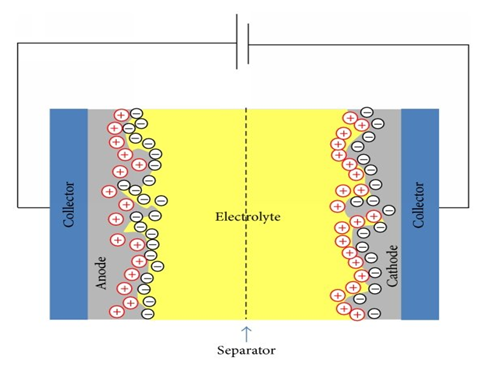
At the core of a supercapacitor are two electrodes and a separator immersed in an electrolyte. When voltage is applied, positive and negative charges accumulate on the electrodes, forming what is known as the electric double layer. This mechanism allows the supercapacitor to store large amounts of energy without undergoing chemical reactions.
There are two main types of capacitances at work:
- Electrostatic (double-layer) capacitance – energy stored by charge separation.
- Pseudocapacitance – energy stored through fast, reversible redox reactions at the electrode surface.
Some advanced designs combine both mechanisms, increasing energy density without compromising speed.
🔬 Materials That Make a Difference
The performance of a supercapacitor is highly influenced by the materials used in its electrodes. Scientists and engineers are exploring various nanostructured materials to improve energy density and charge retention.
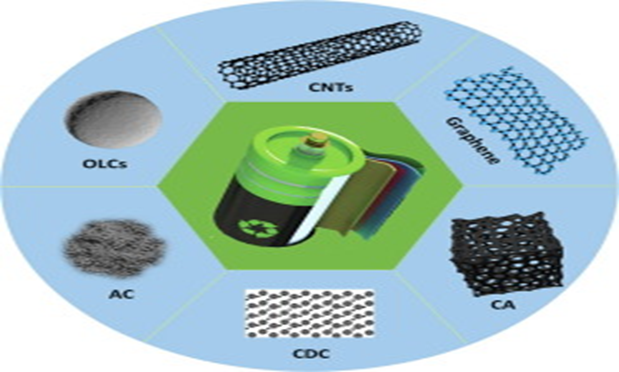
- Activated carbon: High surface area but relatively low conductivity.
- Graphene: Lightweight, strong, and has exceptional conductivity.
- Carbon nanotubes: Improve surface interaction and power density.
- MXenes: A new class of 2D materials with excellent conductivity and mechanical stability.
- Conducting polymers and metal oxides: Used in hybrid capacitors for added Pseudocapacitance.
These innovations aim to increase energy storage capacity while maintaining fast charge-discharge performance.
🚀 Real-World Applications
Supercapacitors are already being used in a wide range of industries and products:
- Electric Vehicles (EVs)
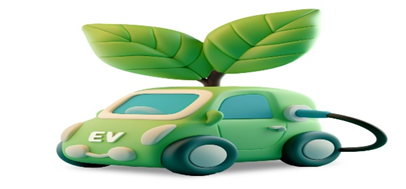
Supercapacitors are employed in regenerative braking systems, where they capture and reuse energy generated during braking. They also provide quick bursts of power for acceleration, enhancing performance and extending battery life.
- Renewable Energy

Solar and wind energy systems experience fluctuations. Supercapacitors help stabilize power delivery by absorbing and releasing energy almost instantly, making renewable systems more efficient and reliable.
- Consumer Electronics

In mobile devices, wearables, and cameras, supercapacitors serve as backup power sources or supplement batteries during high-drain operations. Their quick charge and long life make them ideal for portable tech.
- Industrial and Aerospace

From powering sensors in extreme environments to starting aircraft engines, supercapacitors offer reliable energy storage in high-performance scenarios where traditional batteries may fail.
🌱 A Greener Alternative

Supercapacitors are considered environmentally friendly. They are more recyclable than batteries, contain fewer toxic chemicals, and generally last much longer. Their quick charge capabilities also reduce energy wastage in high-usage systems. This aligns with global sustainability goals focused on reducing electronic waste and improving energy efficiency.
🔮 The Road Ahead
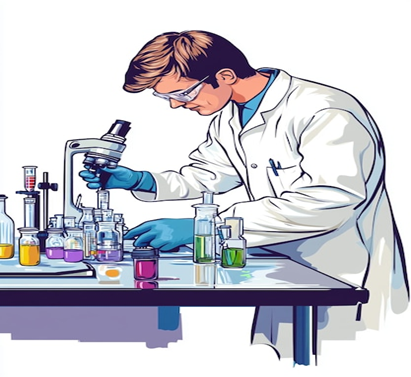
Despite their advantages, supercapacitors still have one major drawback: low energy density compared to batteries. However, researchers are actively working on:
- Hybrid supercapacitors that combine features of batteries and capacitors.
- Flexible and wearable supercapacitors for smart textiles and medical devices.
- Solid-state electrolytes to improve safety and energy density.
- AI-assisted materials discovery for next-gen performance optimization.
These trends point to a future where supercapacitors will not only complement batteries but could eventually replace them in many applications.
💡 Final Thoughts

As we charge into an era of electrification and smart technologies, supercapacitors are becoming more than just an alternative—they’re a necessity. Their high power, rapid response, long lifespan, and sustainable profile make them an exciting solution for modern energy challenges.
In a world that demands both speed and sustainability, supercapacitors are not just the future—they’re already here.

